| Oracle® Fusion Middleware User's Guide for Oracle Enterprise Content Management Solutions for Oracle E-Business Suite 11g Release 1 (11.1.1) Part Number E17124-01 |
|
| View PDF |
| Oracle® Fusion Middleware User's Guide for Oracle Enterprise Content Management Solutions for Oracle E-Business Suite 11g Release 1 (11.1.1) Part Number E17124-01 |
|
| View PDF |
User's Guide for Oracle Enterprise Content Management Solutions for Oracle E-Business Suite
11g Release 1 (11.1.1)
E17124-01
May 2010
This document describes how to use the Enterprise Content Management Solutions for E-Business Suite. It is intended for users whose E-Business Suite application has been extended with an Enterprise Content Management solution.
This document contains the following main sections:
This section covers the following topics:
The Imaging Solution provides imaging, capture, and workflow capabilities via Oracle Imaging and Process Management (I/PM). Depending on configuration, use the Imaging Solution for tasks such as the following:
Launch I/PM from E-Business Suite, and select and perform workflow tasks. When you select a task, you acquire it for your use and it is no longer available to other users.
View attached images and metadata values. Use I/PM's tools for viewing, annotating, and redacting images, as your permissions allow.
Key entries in E-Business Suite while viewing images and related values in the I/PM viewer. See "Keying Entries From Images".
Perform actions related to the workflow task, such as routing, canceling, updating, and completing tasks.
Scan or upload supporting documents for a selected E-Business Suite record.
View supporting images for an E-Business Suite record without leaving the E-Business Suite application.
An Imaging Solution configured for invoice processing might work as follows:
A workflow process automatically generates user tasks.
An invoice is uploaded, metadata values are assigned, and a task for processing the invoice is generated. Typically, tasks are pooled into profiles from which groups of users select. You may have access to tasks in multiple profiles.
From E-Business Suite, you launch the invoices imaging solution, by selecting a command called Process Invoices from the Zoom menu (or other special menu or key).
You select a task from those listed for a selected profile. Once you select (acquire) a task, it is no longer available to other users.
In the Task Viewer, you view the task's invoice image, key entries in E-Business Suite based on the image, and perform related commands.
Additional action commands are typically provided in a side panel. You might route the task to another user or group for approval, add comments for others to view, skip the task, or re-scan or delete the task's document.
You complete the task and begin another, if desired.
Most often, changes you make in E-Business Suite are synchronized with I/PM, and vice versa.
When configured, the Imaging Solution enables you to easily key entries in E-Business Suite while viewing a related image on another monitor. For example, you might follow this sequence to process invoices:
From E-Business Suite's invoice entry screen, start the invoice imaging solution.
Select a task. In the Task Viewer screen, view the invoice image and its associated metadata values.
In the invoice entry screen, key in entries such as invoice amount and date.
Save the invoice entry in E-Business Suite.
Complete the task.
Values are synchronized between I/PM and E-Business Suite. For example, suppose the amount was incorrectly listed in the I/PM summary values. If you entered a different amount in the invoice entry screen (based on the invoice image), the I/PM metadata value is updated.
If configured, the invoice image is stored as an attachment to the corresponding E-Business Suite record.
You repeat steps 2 through 5 to create additional invoice records, keying from their displayed images.
An Imaging Solution configured for capturing supporting documents might work as follows:
From E-Business Suite, you retrieve a record such as an employee record.
You launch the document imaging solution, by selecting a command called Scan Employee Document from the Zoom menu (or other special menu or key).
Oracle Distributed Document Capture launches and automatically initiates a scan (if a scanner is attached to the desktop) or enables you to upload electronic images from your desktop.
You enter index values (metadata) in Oracle Distributed Document Capture to store with the images.
You click Send, which transmits the captured document images and their metadata from Oracle Distributed Document Capture to Oracle I/PM.
An Imaging Solution configured for viewing supporting documents might work as follows:
From E-Business Suite, you retrieve a record such as an employee record.
You launch the document imaging solution, by selecting a command called View Employee Documents from the Zoom menu (or other special menu or key).
From the list of documents associated with the employee record and their metadata values, you select a document.
The document is displayed in the Oracle I/PM viewer, where you can view its images, and with appropriate permissions, apply annotations or redactions.
This section describes how to perform the following tasks in the Imaging Solution.
Starting the Solution
Working with the Task List
Performing Tasks
Follow these steps to display the Imaging Solution from an E-Business Suite record.
Display a supported E-Business Suite form.
From the toolbar, click the Zoom icon shown below. (Depending on configuration, you may instead select a specific menu or press a specific key.)
From the Zooms menu (or similar menu), select the solution command and click OK. For example, if using an invoice processing imaging solution, you might select Process Invoices. For a document imaging solution, you might select a command called Scan Employee Document or View Employee Documents.
Note:
Depending on configuration, you may be prompted to enter a username and password to log in to the solution.Depending on the solution command you selected, imaging-related options are displayed. For example:
If you selected a Process Invoices command for a workflow imaging solution, the Task List Screen is displayed. If needed, select a profile in the Profile field. Tasks are associated with a profile, and users assigned a profile can access any of its tasks not currently selected by other users. After you select a profile, a list of tasks is displayed. See "Viewing and Selecting Tasks".
If you selected a Scan Employee Document command for a supporting document imaging solution, an application called Oracle Distributed Document Capture launches, enabling you to either scan from a desktop scanner or upload electronic images for the E-Business Suite employee record.
If you selected a View Employee Documents command for a supporting document imaging solution, a list of documents associated with the selected employee record displays, enabling you to view selected documents.
Follow these steps to view a list of available tasks and begin performing them.
When you select a task, it is acquired for your use and no longer available to other users also assigned the selected profile. It remains selected until you complete or release the task, even if you close the browser and the session times out. The next time you view the task list, it remains listed as one of your tasks. To release (unacquire) a task, see "Releasing Tasks".
Start the Imaging Solution as described in "Starting the Imaging Solution".
In the Profile field, select a profile, if needed.
Tasks are associated with a profile, where users assigned the profile can access its tasks. After you refresh the display, a list of the profile's tasks is displayed.
From the Task List Screen, select a task.
To perform tasks without selecting them manually, click Auto Task. In this mode, tasks are automatically assigned and displayed in the Task Viewer Screen.
To manually select a task, click its View Task link in the Action column. The task is displayed in the Task Viewer Screen.
A side panel may list additional task list actions you can perform.
Follow these steps to use auto task mode, in which tasks are automatically displayed for you in the Task Viewer Screen, instead of you selecting them individually from the Task List Screen.
Display the Task List Screen.
Click Auto Task.
The Task Viewer Screen is displayed with your first task. After you complete a task, the next task is automatically displayed in the viewer.
To exit auto task mode, click the link for returning to the task list from the side panel.
When you select a task, it becomes acquired by you, until you either complete or release it. (If you close your browser without completing a task, the task remains listed in your task list when you next view the list.)
Releasing a task makes it available to all users assigned its associated profile. Follow these steps.
Display the Task List Screen.
Select a task to release.
Click Release.
You can adjust the task list in the following ways:
Follow these steps to hide or display columns in the Task List Screen.
Display the Task List Screen. (If needed, choose a profile in the Profile field.)
Click the View menu, select Columns, and select a column to hide or display it.
Selecting a column hides it if displayed, and displays it if hidden. A checkmark is displayed next to columns selected for display.
Select Show All to display all columns.
Click the Refresh button shown below.
For ease of use, you can change the order in which columns are displayed and their width. Follow these steps to reorder and resize columns.
Display the Task List Screen. (If needed, choose a profile in the Profile field.)
To resize a column, hover the cursor over its heading until a double arrow is displayed, then click and drag to increase or decrease its width.
Reorder columns using either of these methods:
Click a column's heading row, and drag and drop it to a new location. Columns are reordered.
Click View, then Reorder Columns. In the Reorder Columns popup displayed, select columns to display and click the up and down buttons to reorder them. The column you position topmost in this popup is displayed leftmost in the task list table. Click OK.
Follow these steps to display an expanded view of the task list in a detached, movable screen.
Display the Task List Screen. (If needed, choose a profile in the Profile field.)
Click Detach. The list of tasks is displayed in its own screen within the application screen. The Detached button appears pressed.
To return the list of tasks to its attached position, click Detach again.
Follow these steps to view a document associated with a selected task in the I/PM viewer.
Display the Task Viewer Screen, either by selecting a task or choosing Auto Task in the Task List Screen.
The task's document is displayed in the I/PM viewer in the large panel of the Task Viewer Screen. The document title is listed in the top tab.
Note:
The first time you access the viewer per session, you may be prompted to log in to I/PM. Enter a username and password and click Sign In.Use the I/PM viewer toolbar buttons to perform tasks such as rotating images, zooming in or out, or moving between pages of the document.
For more information, see the Oracle Fusion Middleware User's Guide for Oracle Imaging and Process Management.
If needed, switch between the basic and advanced viewer. (You must use the advanced viewer for annotations.)
In addition to the I/PM image viewer, the Task Viewer screen typically displays Task Actions, Summary, and Comments side panels that relate to the selected task.
The I/PM Viewer panel shows the document's image, along with related options. See "Viewing Document Images".
The Task Actions panel lists action commands related to the task, such as routing, updating, or completing actions.
The Summary panel lists key metadata values assigned to the document in I/PM for quick reference. For example, in an Invoice Processing scenario, invoice number and supplier name might be listed.
The Comments panel lists comments entered for the task by users. See "Viewing and Entering Comments".
You can customize the task viewer as follows:
To hide a panel, click its minus (-) sign box. The panel collapses and the sign changes to a plus (+). To show a panel, click its plus (+) sign.
To resize a panel, hover the cursor at the top of its title bar. When it becomes a two-headed arrow, click and drag it up or down to change its size.
You can use the basic or advanced viewer. You must use the advanced viewer to add annotations, as your permissions allow.
Tip:
Click the Preferences link at the top of the screen to set the basic or advanced viewer to display by default.When performing tasks, you may need to identify a user or group of users. For example, in an invoice processing solution, you might search for users to request an invoice's approval. Follow these steps to search for a user or group of users and select them. (Depending on configuration, you search for either users or groups.)
Display the Select User/Group Screen.
This screen is displayed whenever you choose an action command requiring a user or group selection.
In the Search field, specify the criteria by which you are searching, such as by user name or group name.
In the entry field, specify the value for which you are searching.
For example, if searching by username, enter a portion or all of the user's name. You can enter an asterisk (*) as a wildcard character to match one or more characters. For example, type Acc* to search for a group called Accounting.
Click Search to perform the search.
Note:
On a large system, the search could take a while. The more specific your search criteria, the faster results are displayed.From the search results displayed in the Available Values field, select one or more users or groups and click Move to move them to the Selected Values field. If needed, click Remove or Remove All to remove users or groups.
Click OK.
When performing tasks, you may need to select an item from a list of choices. For example, in an invoice processing solution, you might select a processing group from several choices. Follow these steps to select an item.
Display the Select Item Screen.
This screen is displayed whenever you select an action command requiring an item selection.
From the field listing choices, select an item and click OK. Click Cancel to exit the screen without a selection.
The Task Viewer Screen typically includes a Comments side panel that lists the first portion of comments entered by users about the selected task. Follow these steps to view complete comments or add them.
In the Comments panel in the Task Viewer Screen, click the glasses icon shown below to view all comments.
A View Comments popup is displayed, listing comments in the order in which they were added, along with the date and user who entered the comment. Click OK to close the popup.
To add a comment, click the Add Comment icon shown below. Enter a comment in the Comment Text field of the popup and click OK. The new comment is displayed at the bottom of the comments list.
The Imaging Solution contains the following user interface screens:
Use this screen to view and select from a list of tasks available to you, based on a selected profile. You can also select related links (if present), and activate auto task mode for automatically selecting tasks.
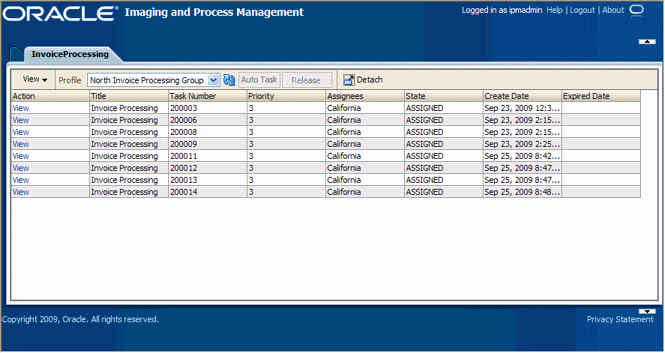
To display this screen, start the Imaging Solution in E-Business Suite by clicking the Zoom menu icon in the toolbar (or other specified menu or key), choosing the solution command, and clicking OK. For example, if using an Invoice Processing solution, select the Process Invoices solution command.
| Element | Description |
|---|---|
| Task List Links | Depending on configuration, this side panel may list task list-related links. (This side panel may not be displayed.) For example, it might include links to external informational sites, shortcuts to commonly used instructions or internal organization links. |
| View | Use this menu to reorder columns, hide or display columns, and detach the task list to a floating screen. |
| Profile | If needed, select a profile (category to which tasks are assigned) to view its tasks. You may be assigned multiple profiles. |
| Click to update the task list display. | |
| Auto Task | Click to activate auto task mode, in which tasks are automatically selected and displayed in the Task Viewer Screen, instead of you selecting them manually from the Task List Screen. |
| Release | Click to make a previously selected task available to all users assigned its profile.
Note: When you select a task, it becomes acquired by you, until you either complete or release it. (If you close your browser without completing a task, the task remains listed in your task list when you next view it.) |
| Detach | Click to expand the task list to a floating window you can reposition on the screen. To attach, click Detach again. |
| Table | The task list table lists available tasks and their related information. The columns listed depend on configuration. Note that you can hide, display, or reorder columns using View menu options. |
| View Task | Click this link to view the selected task in the Task Viewer Screen. |
Use this screen to view information about the selected task and perform actions for it.
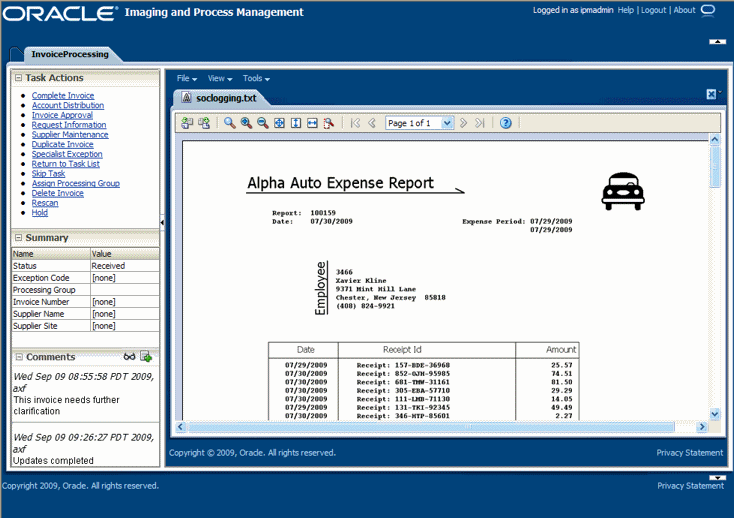
Display this screen from the Task List Screen in one of two ways: by clicking a specific task's View Task link or by clicking Auto Task.
| Element | Description |
|---|---|
| Action Commands | This side panel typically lists action commands for the selected task. Common tasks include: Complete Task, Skip Task, and Return to Task List, plus tasks specific to the business use. |
| Summary | Displays metadata values stored in I/PM for the document, for reference. |
| Comments | Displays the first line of comments users have entered for the selected task. Use this area to view or enter comments. |
| I/PM Image Viewer | Displays the task's associated images in the basic or advanced I/PM image viewer. For more information on I/PM viewer options, see the Oracle Fusion Middleware User's Guide for Oracle Imaging and Process Management. |
Use this screen to search for and select a user or group of users.
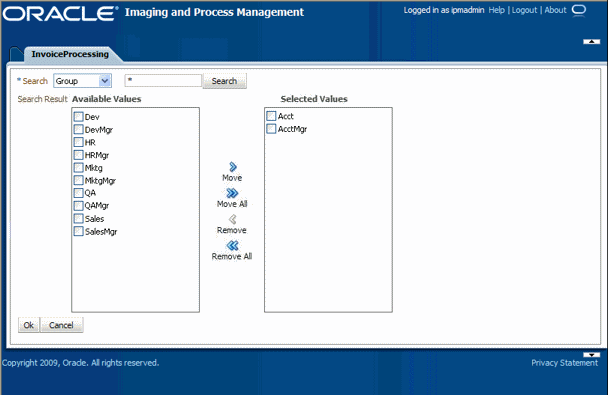
Display this screen by selecting a command requiring a user or group selection. For example, clicking an action command called Approval on the Task Viewer Screen might display the Select User/Group screen for selecting a group to request approval for a selected document.
Use this screen to select an item from a list of choices.
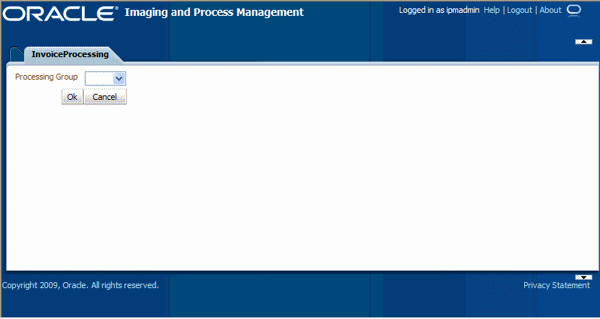
Display this screen by choosing a command requiring a selection. For example, clicking an action command called Assign Processing Group on the Task Viewer Screen might display the Select Item screen for assigning the task to a selected processing group.
| Element | Description |
|---|---|
| Item Selector | From the field listing choices, select an item and click OK. |
| OK | Exit the screen and use the selection made. |
| Cancel | Exit the screen, discarding any selection made. |
This section covers the following topics:
The Managed Attachments Solution allows business users to attach, scan, store, and retrieve attachments stored in an Oracle UCM Content Server repository. An Oracle UCM repository enables users throughout an enterprise to view, collaborate on, and retire content, ensuring that content is secure, accurate, and up-to-date.
This section describes how to perform the following tasks using the Managed Attachments Solution screens. For more information about Content Server procedures, see the Oracle Fusion Middleware User's Guide for Content Server.
Viewing Attachments
Attaching and Detaching Documents
Editing Attachments
Finding Attachments
Follow these steps to display the Managed Attachments screen for an E-Business Suite record.
On an E-Business Suite form that supports managed attachments, display a record, and save it, if needed. (For example, create and save an invoice.)
From the toolbar, click the Zoom icon shown below.
From the Zooms menu, choose Managed Attachments and click OK.
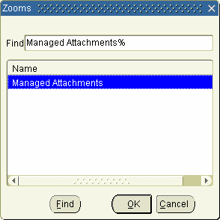
Note:
Depending on configuration, you may be prompted to enter a username and password to log in to Oracle UCM. If prompted, enter the same username that you use to log in to E-Business Suite.The Managed Attachments Screen is displayed, listing current attachments for the selected E-Business Suite record. The line across the top provides key values for the associated E-Business Suite entity.
Note:
You have access to the Managed Attachments screen for a certain amount of time. After a period of inactivity or total access time is reached, a message is displayed stating that your access privileges may have expired. To access the Managed Attachments screen, select the Managed Attachments command again from the Zoom menu as described in this section.Follow these steps to select and order fields for display in the Managed Attachments screen.
In the Managed Attachments screen, click the Configure icon, as shown below.
On the Configure Fields for Display Screen, specify fields to display by selecting them in the Available Fields area (holding down the Ctrl key to select multiple fields) and clicking the right arrow button to move them to the Main Information area. (Fields selected for display are displayed in dimmed text in the Available Fields area.)
Change the order in which fields are displayed by repositioning them in the Main Information area. Move a field by selecting it and clicking the up or down arrow button.
Note:
If needed, click Reset to restore the default field display and order.Click Apply and view the results of your changes.
When done, click Save and Exit, and close the Configure Fields for Display screen.
Follow these steps to view an attached document's metadata values or previous revisions
In the Managed Attachments screen, click the Info icon (displayed in the Info column) for a selected attachment.
View details about the document on the Content Information Screen.
Follow these steps to check in a document and attach it to the selected E-Business Suite record.
In the Managed Attachments screen (see "Displaying Managed Attachments"), click New.
Complete the fields on the Content Check In Form.
In the Type field, select a type for the document. The default is EBSAttachment - Documents attached to E-Business Suite entities.
In the Title field, enter a name for the attached document.
Select the Share Document field to make the document available to other Oracle UCM users with appropriate access. Leave the field deselected (default) to make the document available when viewed through E-Business Suite but hidden from the standard Oracle UCM user interface. (All users can see private (not shared) attachments when they enter Oracle UCM through E-Business Suite, regardless of who checked them in.)
In the Security Group field, select a group for the document. If shared, the attachment is available to users who have permission to this group. (This field is available only if the Share Document field is selected.)
Specify the file to attach in the Primary File field by clicking the Browse button and selecting a file.
Close the Check In Confirmation screen.
In the Managed Attachments screen, click Refresh to display the newly checked in attachment.
The Managed Attachments screen provides a Scan button that, when configured, launches the Oracle Distributed Document Capture application and enables you to either scan a document using a TWAIN compliant scanner or import a scanned image file from disk. After reviewing, editing, and indexing the document, click Send, which transfers it from Oracle Distributed Document Capture to Oracle UCM and attaches it to the selected E-Business Suite entity.
Follow these steps to scan or import a document.
If scanning documents, place the documents in the feeder tray of the scanner.
In the Managed Attachments screen, click Scan. The Scan Document screen is displayed.
Select a classification in the Document Classification field.
This identifies the type of document to be scanned or imported. For example, you might choose a document classification of Identity Documents to scan a photocopy of a driver's license or passport.
Select the Share Document field to make the document available to other Oracle UCM users with appropriate access. Leave the field deselected (default) to make the document available when viewed through E-Business Suite but hidden from the standard Oracle UCM user interface.
In the Security Group field, select a group for the document. Attachments are available only to users who have permission to the group you select. (This field is available only if you chose to share the document in the previous step.)
Click Scan Document. The Oracle Distributed Document Capture client application launches and displays options based on whether the selected document classification is configured for scanning or importing.
If set for scanning, the scanner scans the pages you placed in the feeder and displays them in the Review/Index screen shown in Figure 1, ready for you to review and index them. (All pages are scanned and stored in one document in the batch.)
If set for importing, a File Import screen is displayed, prompting you to select one or more scanned image files to import. After you select files, their pages are displayed in the Review/Index screen shown in Figure 1, ready for you to review and index. (All files are imported into a single document in a single batch.)
In the Review/Index screen, review, edit, and index the document. For information, see the User's Guide for Oracle Distributed Document Capture. Follow these guidelines:
You can add pages to documents, but should not add documents to the batch.
Index fields are displayed in the lower side panel. Index fields provide values that are stored as metadata with the Oracle UCM document. An asterisk is displayed before the names of required index fields.
All pages in a document have the same index values. Changing the values on one page changes them for all pages in the document.
When done, click Send to transfer the document to Oracle UCM and attach it to the E-Business Suite record. When asked to confirm sending the batch, click Yes.
Note:
If required index fields are not complete, you are prompted to complete them to send the batch.The client displays batch send results.
Close the Batch Send Results and Oracle Distributed Document Capture screens.
In the Managed Attachments screen, click Refresh to display the newly scanned or imported document now attached to the selected E-Business Suite record. Note that it may take a few minutes for the generated document to be displayed.
Follow these steps to search for and attach documents from the Oracle UCM repository to the selected E-Business Suite record.
In the Managed Attachments screen, click From Repository. The Expanded Search Form is displayed.
Enter search criteria and click Search. For example, for the Title field, select Starts and enter the first few characters of a document's title.
Search results are displayed, which include documents to which you have security group access.
In the Select field, select found documents to attach. If a found document is attached to the E-Business Suite record, the field is disabled. You can select multiple documents to attach.
From the Actions menu above the Select field, choose Attach to current Application Entity. Confirm the attachment of the selected document(s) to the E-Business Suite record. A message states that the documents were successfully attached.
In the Managed Attachments screen, click Refresh to display the document(s) now attached to the selected E-Business Suite record.
Follow these steps to detach a document from the selected E-Business Suite record. Detaching a document removes the link to the E-Business Suite record, but does not delete the document from the Content Server. (Also see "Deleting a Document on Content Server".)
In the Managed Attachments screen, select the row corresponding to the attachment you want to detach from the selected E-Business Suite record.
Click Detach.
A message prompts you to verify the action. Click OK.
A message confirms that the document was successfully detached. After you close the message, the attachment list is automatically refreshed, with the detached document no longer listed.
Follow these steps to open a document in a Web-viewable format or save the document in its native format to a selected location such as a local computer. Note that changes you make to a document in this way are not saved on the Content Server; instead, see "Editing a Document in its Native Application".
In the Managed Attachments screen, click a selected document's link in the Name field. A File Download dialog box is displayed with options to open or save the file.
Click Open or Save.
Follow these steps to edit a document on the Content Server. Note that you must have access to the native application.
In the Managed Attachments screen, click the Edit icon for a selected attachment. (The Edit icon is displayed only for documents that can be edited in this way.)
The document opens in its native application. Note that, depending on configuration, you may be prompted to enter a username and password to log in.) Make changes and save the document.
When you open the document using this method, it is automatically checked out. When you save the document in its native application, it is automatically checked back in as a new revision.
Follow these steps to make changes to a selected document's metadata values.
In the Managed Attachments screen, click the Properties icon for a selected attachment.
Make changes to the document's metadata values on the Info Update Form.
Click Submit Update.
Follow these steps to remove a document from the Content Server and also detach it from the E-Business Suite record. To detach a document only (remove its link to the selected E-Business Suite record without deleting it from the Content Server), see "Detaching a Document".
In the Managed Attachments screen, click the Info icon for a selected attachment.
Under Actions options, click the Delete link for the revision you want to delete. You are prompted to confirm the deletion.
Follow these steps to search for documents on the Content Server.
Note:
Private (not shared) attachments are not returned in search results when searching in this way from within E-Business Suite.In the Managed Attachments screen, click From Repository.
Specify search criteria on the Expanded Search Form.
For example, to search for a document by its name, select Starts in the Title field and enter the first portion of its name in the adjacent field.
Click Search. Search results are listed.
The Managed Attachments Solution contains the following user interface screens:
Use the Managed Attachments screen to view, attach, scan, detach, and edit Oracle UCM documents attached to the selected E-Business Suite record. You can also launch the Oracle UCM application, and activate its search options to locate Oracle UCM documents to which you have access.
The Managed Attachments screen lists all Oracle UCM documents attached to the selected E-Business Suite record, and provides the options listed in Table 1.
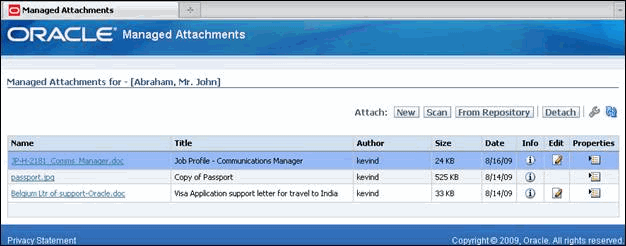
About the Managed Attachments Screen
Metadata fields and values for the selected E-Business Suite record are displayed in the line at the top of the screen. For example, a managed attachments list for an invoice E-Business Suite record might display its invoice number and supplier name.
The default columns are described in Table 1, although users can customize the columns displayed.
If the list of attachments is long, arrows for displaying previous and next pages are displayed at the bottom.
You can resize the columns by hovering the cursor over the line between column headings; when it changes to a two-headed arrow, click and drag to increase or decrease the column's size. Column contents wrap to the next line.
To sort the attachments list, click a column heading. A triangle is displayed after sorting to indicate ascending or descending order.
Depending on settings, some functionality described in this section may not be available. For example, certain buttons may not be displayed or icons may be disabled (grayed out).
The Managed Attachments screen is available for a certain amount of time. A message is displayed if your access expires, requiring you to select the Managed Attachments command again for the selected E-Business Suite record.
Table 1 Managed Attachments Screen Options
| Elements | Description |
|---|---|
|
Name |
Lists the native name (including extension) of each Oracle UCM document attached to the E-Business Suite record. Click the document's link to open or save a Web-viewable rendition of the document. |
|
Title |
Displays the title of the attached Oracle UCM document, assigned at checkin. |
|
Author |
Identifies the person who checked in the file. |
|
Size |
Displays the size (KB/MB) of the attached Oracle UCM document. |
|
Date |
Displays the date on which the Oracle UCM document was last submitted to Oracle UCM. |
|
Info |
Click this icon to display detailed information and content actions for the selected document on the Content Information Screen. |
|
Edit |
Click this icon to check out, open, and edit the attached Oracle UCM document in its native application. |
|
Properties |
Click this icon to update metadata values for the attached Oracle UCM document on the Info Update Form. |
|
New |
Click this button to attach an Oracle UCM document to the selected E-Business Suite record, by completing fields on the Content Check In Form. |
|
Scan |
Click this button to scan or import a document and attach it to the E-Business Suite record. |
|
From Repository |
Click this button to search for files on the Content Server. |
|
Detach |
Click this button to detach the selected Oracle UCM document. Detaching removes the Oracle UCM document from the E-Business Suite entity, but not from Oracle UCM. |
|
Configure |
Click this button to select and order fields for display in the Managed Attachments screen on the Configure Fields for Display Screen. |
|
Refresh |
Click this button to update the Managed Attachments display. |
Use the Content Check In Form to check in documents to Content Server, assign them metadata values, and attach them to the selected E-Business Suite record.
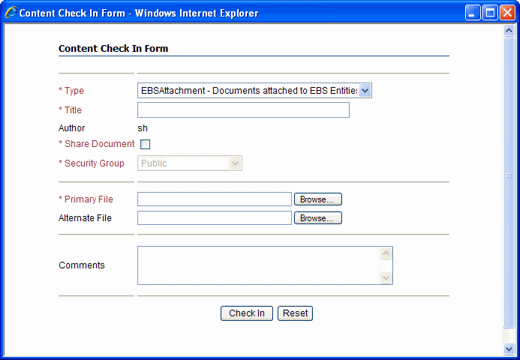
To display this form, click New in the Managed Attachments Screen.
| Elements | Description |
|---|---|
| Type | Select the option that best describes the file. The default document type for managed attachments is EBSAttachment. This field is required. |
| Title | Enter a descriptive title for the document. This field is required. |
| Author | Identifies the person who checked in the file. This field is required. |
| Share Document | Select this field to make the document available to other Oracle UCM users with appropriate access. Leave the field deselected (default) to make the document available when viewed through E-Business Suite but hidden from the standard Oracle UCM user interface. |
| Security Group | Select a security group for the file. Keep in mind that this file, if shared, is available to users who have permission to the specified security group. This field is required. |
| Primary File | Specify a primary file using one of these methods:
This field is required. |
| Comments | Enter any notes about the file. |
| Check In | Click this button to check in the specified document using the settings selected on this screen. |
| Reset | Click this button to cancel any entries and restore the default settings in this screen. |
The Configure Fields for Display screen allows E-Business Suite users to specify the attachment information they want displayed in the Managed Attachments screen.
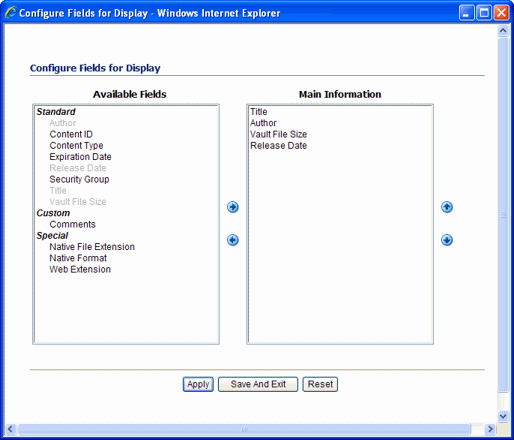
To display this screen, click Configure in the Managed Attachments Screen.
| Elements | Description |
|---|---|
| Available Fields | Lists fields available for display in the Managed Attachments screen. Click the right arrow to move a selected field to the Main Information area. Fields selected for display are shown in dimmed characters. |
| Main Information | Lists fields selected for display in the Managed Attachments screen. Fields are displayed left to right in the order in which they are listed in this area. Click the up or down arrow button to reposition a selected field. |
| Apply | Click this button to preview your changes in the Managed Attachments screen. (If needed, temporarily reposition the Configure Fields for Display screen to view screen changes.) |
| Save And Exit | Click this button to save changes to the display configuration and return to the Managed Attachments screen. |
| Reset | Click this button to cancel any changes and restore the default system field display. |
Use the Content Information screen to view details about the attached file, view its web-viewable or native version, and if needed, delete the document.
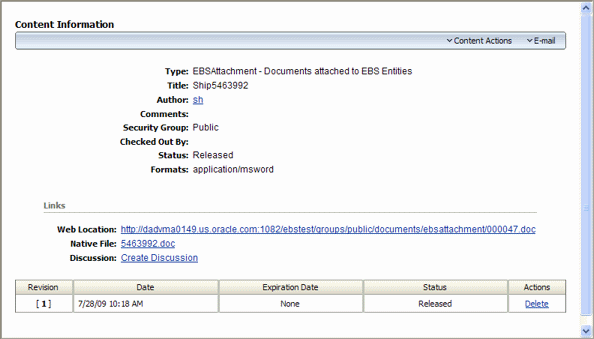
To display this screen, click the Info button for a selected document in the Managed Attachments Screen.
| Elements | Description |
|---|---|
| Type | Displays the type that best describes the file. The default document type for managed attachments is EBSAttachment. |
| Title | Displays the title of the attached Oracle UCM file, assigned at checkin. |
| Author | Identifies the person who checked in the file. |
| Comments | Displays additional notes about the file. |
| Security Group | An identifier that specifies access permission to the file. |
| Checked Out By | Identifies the user who has the file checked out. |
| Status | Identifies the file's current status. A status of Released indicates that the revision is available in the Content Server. |
| Formats | Identifies formats for the file. |
| Web Location | Click this link to view a web-viewable rendition of the attached file. |
| Native File | Click this link to either save a copy of the file or open it in its native application. |
| Table | Lists revisions of the file, along with their release date, expiration date, and status. Click the Delete link to remove the corresponding revision. |
| Content Actions | Provides options for checking out the file, updating it, checking in a similar file, subscribing to the file, or checking out and opening the file. |
| The Send Link by E-mail link opens a new e-mail message that contains a URL to the selected file. |
Use the Update Info Form to make changes to a selected document's metadata values. Users search for documents on the Content Server by their metadata values.
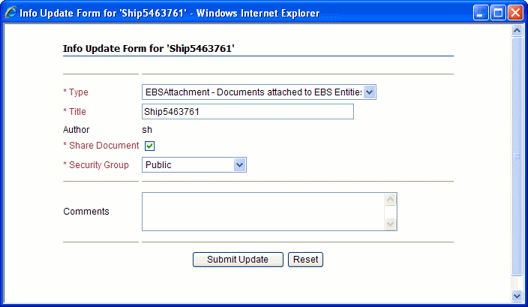
To display this form, click the Properties icon for a selected attachment in the Managed Attachments Screen.
| Elements | Description |
|---|---|
| Type | Select the option that best describes the file. The default document type for managed attachments is EBSAttachment. |
| Title | Enter a descriptive title for the document. |
| Author | Identifies the user who checked in the current file revision. |
| Share Document | Select this field to make the document available to other Oracle UCM users with appropriate access. Leave the field deselected (default) to make the document available when viewed through E-Business Suite but hidden from the standard Oracle UCM user interface. |
| Security Group | Specifies access permission to the file. You can enter text or select from the list of predefined values. |
| Comments | Enter any notes about the file. |
| Submit Update | Click this button to save the metadata changes to the attached file. |
| Reset | Click this button to cancel metadata changes and restore them to their values upon entering this form. |
Use the Scan Document screen to specify the type of document you want to scan or import, and then attach to the E-Business Suite entity.
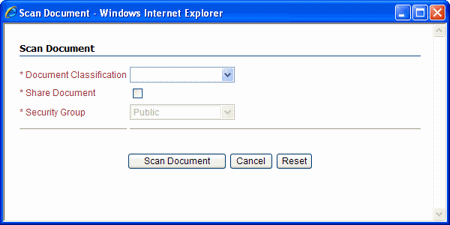
To display this screen, click Scan in the Managed Attachments Screen.
| Element | Description |
|---|---|
| Document Classification | Identify the type of document to be scanned or imported. |
| Share Document | Select this field to make the document available to other Oracle UCM users with appropriate access. Leave the field deselected (default) to make the document available when viewed through E-Business Suite but hidden from the standard Oracle UCM user interface. |
| Security Group | Select a group for the document.
|
| Scan Document | Click to begin scanning or importing the document. |
| Cancel | Click to exit without scanning or importing. |
| Reset | Click this button to cancel any selections and restore the default settings in this screen. |
This search screen enables you to search the Content Server for content. After specifying search criteria and clicking Search, the results are listed.
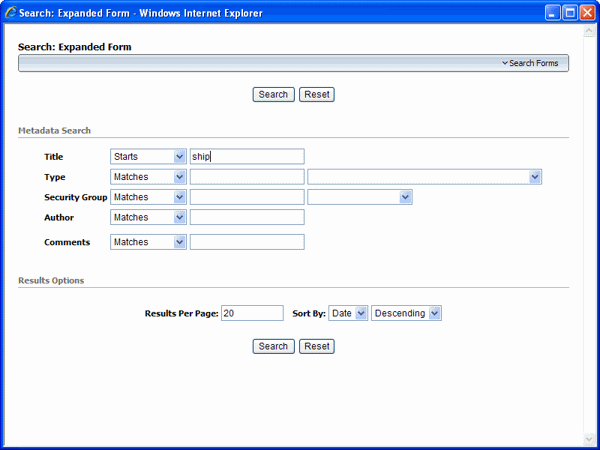
To display this form, click From Repository in the Managed Attachments Screen.
| Elements | Description |
|---|---|
| Title | Select an operator and search for the file's title. |
| Type | Select an operator and search for the file's type. |
| Security Group | Select an operator and search for the file's security group. (To search for private documents, select AFDocuments as the security group.) |
| Author | Select an operator and search for the person who checked in the file. |
| Comments | Specify an operator and search for files by their comments. |
| Results Per Page | Determines the number of results that are displayed on the search results page. |
| Sort By | Determines which of the following options are used to sort the targeted search results, and whether those results are listed in ascending or descending (default) order:
|
| Search | Click this button to perform the search after specifying search criteria. |
| Reset | Resets the form. |
This screen displays the results of your Content Server repository search and enables you to attach one or more selected documents to the selected E-Business Suite record. You can also save or restrict your search using standard Oracle UCM query actions.
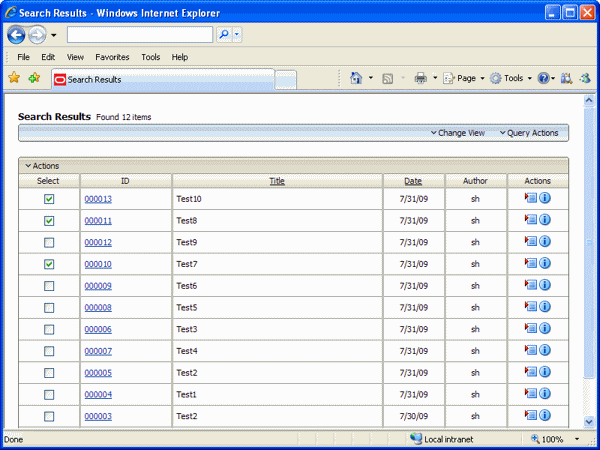
To display this form, click From Repository in the Managed Attachments Screen, specifying a search in the Expanded Search Form and clicking Search.
| Elements | Description |
|---|---|
| Select | Select one or more documents to attach. If a document is attached to the E-Business Suite record, the field is disabled. You can select multiple documents to attach. |
| Actions | From this menu, choose Attach to current Application Entity to attach the selected documents to the E-Business Suite record. |
| Change View | Select another Content Server results view. |
| Query Actions | Optionally save the search for future use. |
Our goal is to make Oracle products, services, and supporting documentation accessible to all users, including users that are disabled. To that end, our documentation includes features that make information available to users of assistive technology. This documentation is available in HTML format, and contains markup to facilitate access by the disabled community. Accessibility standards will continue to evolve over time, and Oracle is actively engaged with other market-leading technology vendors to address technical obstacles so that our documentation can be accessible to all of our customers. For more information, visit the Oracle Accessibility Program Web site at http://www.oracle.com/accessibility/.
Accessibility of Code Examples in Documentation
Screen readers may not always correctly read the code examples in this document. The conventions for writing code require that closing braces should appear on an otherwise empty line; however, some screen readers may not always read a line of text that consists solely of a bracket or brace.
Accessibility of Links to External Web Sites in Documentation
This documentation may contain links to Web sites of other companies or organizations that Oracle does not own or control. Oracle neither evaluates nor makes any representations regarding the accessibility of these Web sites.
Access to Oracle Support
Oracle customers have access to electronic support through My Oracle Support. For information, visit http://www.oracle.com/support/contact.html or visit http://www.oracle.com/accessibility/support.html if you are hearing impaired.
Oracle Fusion Middleware User's Guide for Oracle Enterprise Content Management Solutions for Oracle E-Business Suite, 11g Release 1 (11.1.1)
E17124-01
Copyright © 2008, 2010, Oracle and/or its affiliates. All rights reserved.
This software and related documentation are provided under a license agreement containing restrictions on use and disclosure and are protected by intellectual property laws. Except as expressly permitted in your license agreement or allowed by law, you may not use, copy, reproduce, translate, broadcast, modify, license, transmit, distribute, exhibit, perform, publish, or display any part, in any form, or by any means. Reverse engineering, disassembly, or decompilation of this software, unless required by law for interoperability, is prohibited.
The information contained herein is subject to change without notice and is not warranted to be error-free. If you find any errors, please report them to us in writing.
If this software or related documentation is delivered to the U.S. Government or anyone licensing it on behalf of the U.S. Government, the following notice is applicable:
U.S. GOVERNMENT RIGHTS Programs, software, databases, and related documentation and technical data delivered to U.S. Government customers are "commercial computer software" or "commercial technical data" pursuant to the applicable Federal Acquisition Regulation and agency-specific supplemental regulations. As such, the use, duplication, disclosure, modification, and adaptation shall be subject to the restrictions and license terms set forth in the applicable Government contract, and, to the extent applicable by the terms of the Government contract, the additional rights set forth in FAR 52.227-19, Commercial Computer Software License (December 2007). Oracle USA, Inc., 500 Oracle Parkway, Redwood City, CA 94065.
This software is developed for general use in a variety of information management applications. It is not developed or intended for use in any inherently dangerous applications, including applications which may create a risk of personal injury. If you use this software in dangerous applications, then you shall be responsible to take all appropriate fail-safe, backup, redundancy, and other measures to ensure the safe use of this software. Oracle Corporation and its affiliates disclaim any liability for any damages caused by use of this software in dangerous applications.
Oracle is a registered trademark of Oracle Corporation and/or its affiliates. Other names may be trademarks of their respective owners.
This software and documentation may provide access to or information on content, products, and services from third parties. Oracle Corporation and its affiliates are not responsible for and expressly disclaim all warranties of any kind with respect to third-party content, products, and services. Oracle Corporation and its affiliates will not be responsible for any loss, costs, or damages incurred due to your access to or use of third-party content, products, or services.